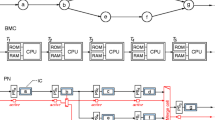Abstract
In this paper we propose a new approach that addresses both the problems of design validation and hardware testing since the early stages of the design flow. The approach consists in adapting the mutation testing, a software method, to circuits described in VHDL. At the functional level, the approach behaves as a design validation method and at the hardware level as a classical ATPG. Standard software test metrics are used for assessing the quality of the design validation process, and the hardware fault coverage for assessing the test quality at the hardware level. An enhancement process that allows design validation to be efficiently reused for hardware testing is detailed. The approach is shown to be efficient upon a set of representative circuits.
Similar content being viewed by others
References
Y. Levendel and P. Menon, “Test Generation Algorithms for Computer Hardware Description Languages,” IEEE Transactions on Computers, Vol. C-31, No. 7, pp. 577–588, 1982.
T. Lin and S.Y. Su, “The S-algorithm: A Promising Solution for Systematic Functional Test Generation,” IEEE Transactions On Computer-Aided-Design, Vol. CAD-4, No. 7, pp. 250–263, 1985.
S. Ghosh and T.J. Chakraborty, “On Behavioral Fault Modeling for Digital Designs,” Journal of Electronic Testing: Theory and Applications, Vol. 2, pp. 135–151, 1991.
J.R. Armstrong, “Chip-Level Modeling with HDLs,” IEEE Design and Test of Computers, Vol. 5, No. 1, pp. 577–588, 1988.
M.C. Hansen and J.P. Hayes, “High-level Test Generation Using Physical-Induced Faults,” IEEE VLSI Test Symposium (VTS'13), Princeton, NJ, USA, pp. 20–28, 1995.
M.D. O'Neill, D.D. Jani, C.H. Cho, and J.R. Armstrong, “BTG: A Behavioral Test Generator,” 9th International Symposium on CHDLs and Their Applications, Washington, 1989, pp. 347–360.
C.H. Cho and J.R. Armstrong, “B-algorithm: A Behavioral Test Generation Algorithm,” International Test Conference, 1994, pp. 968–979.
G. Al Hayek and C. Robach, “From Specification Validation to Hardware Testing: A Unified Method,” International Test Conference (ITC'96), Washington DC, USA, 1996, pp. 885–893.
R. DeMillo, R. Lipton, and F. Sayward, “Hints on Test Data Selection: Help for the Practicing Programmer,” IEEE Computer, Vol. 11, No. 4, pp. 34–41, 1978.
R. DeMillo and A. Offutt, “Constraint-Based Automatic Test Data Generation,” IEEE Transactions on Computers, Vol. 17, No. 9, pp. 900–910, 1991.
Author information
Authors and Affiliations
Rights and permissions
About this article
Cite this article
Al-Hayek, G., Robach, C. From Design Validation to Hardware Testing: A Unified Approach. Journal of Electronic Testing 14, 133–140 (1999). https://doi.org/10.1023/A:1008317826940
Issue Date:
DOI: https://doi.org/10.1023/A:1008317826940



